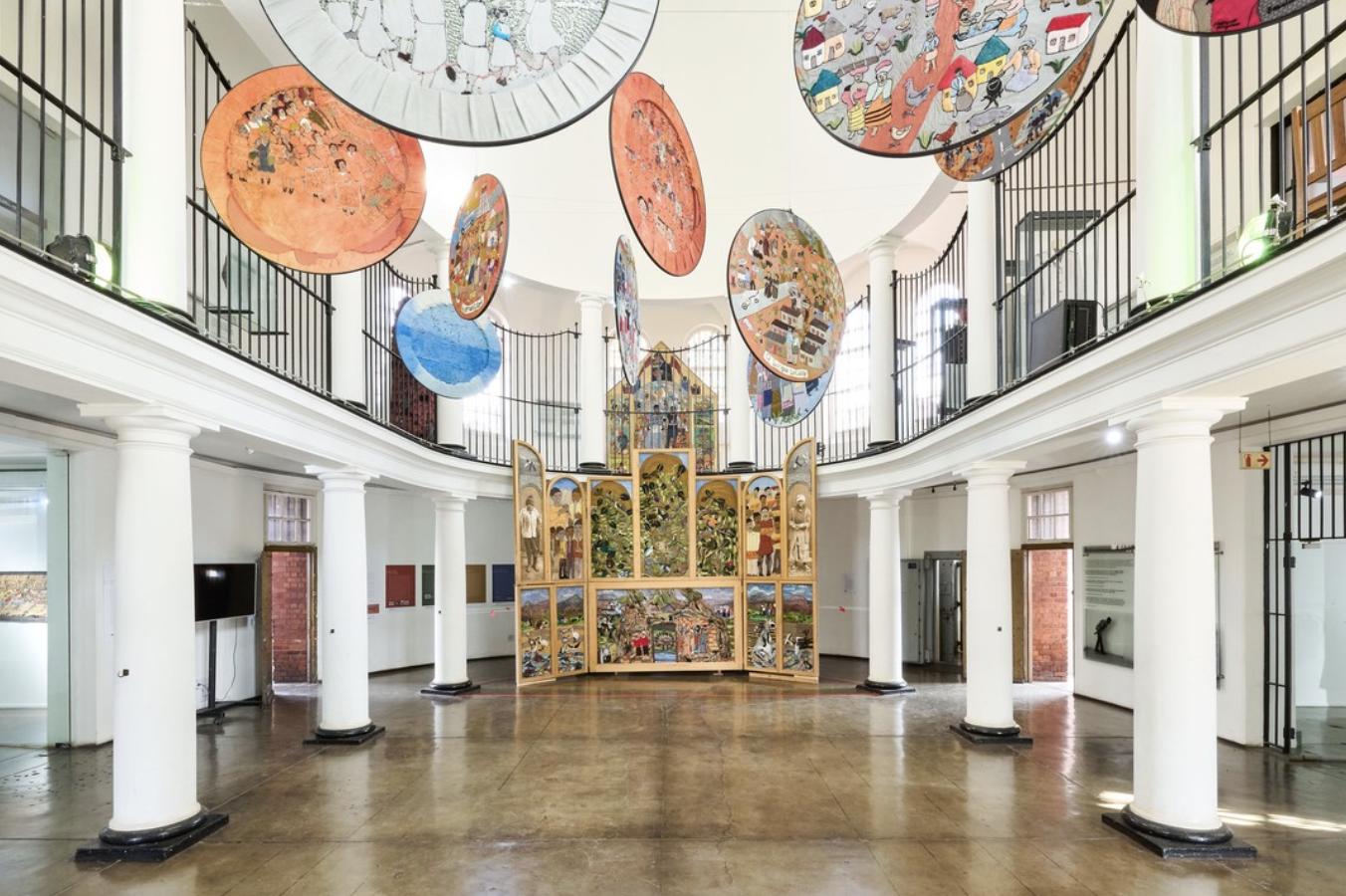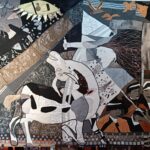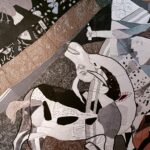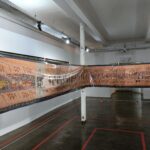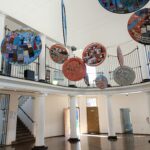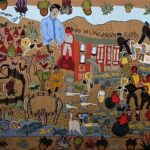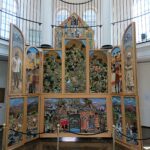London calling | chapter 6
Keiskamma Art Project
Umaf’evuka, nje ngenyanga
Dying and rising, as the moon does
ITA (English below)
Una mostra a Constitution Hill, Johannesburg, celebra gli oltre vent’anni del Keiskamma Art Project, una iniziativa artistica nata e sviluppatasi ad Hamburg, sud-est del Sud Africa. Attraverso l’arte le donne del Keiskamma sono riuscite a dare voce alle proprie storie contribuendo a ricostruire e a preservare le trame della memoria collettiva di una comunità lacerata dalla pandemia HIV/AIDS.
Nel Luglio del 2000 la dottoressa e artista Carol Hofmeyr si trasferì insieme al marito, anch’egli medico, ad Hamburg, un villaggio di duemila abitanti situato lungo le sponde del fiume Keiskamma, nella provincia del Capo Orientale della repubblica sudafricana. Ad Hamburg, la Hofmeyr si trasferì con il primo intento di assistere medicalmente le numerose persone afflitte dal virus HIV/AIDS, e di aiutare la comunità, fortemente colpita dalla pandemia e dalla povertà, con la fondazione di un centro artistico.
Oggi, dopo più di vent’anni, il Keiskamma Art Project è una realtà riconosciuta a livello internazionale: da un piccolo gruppo di donne, adesso impiega più di cento artiste, e le sue opere si trovano in diverse collezioni nazionali ed internazionali. Parte del Keiskamma Trust, una organizzazione no-profit impegnata ad aiutare le comunità del Capo Orientale, il Keiskamma Art Project è stato fondamentale nel preservare e ricostruire la memoria collettiva di Hamburg.
CONSTITUTION HILL
Si dice che nessuno conosce veramente una nazione fino a quando non ne abbia visitato le prigioni.
Una nazione dovrebbe essere giudicata non per il modo in cui tratta i cittadini più prestigiosi, ma i più umili,
e il Sud Africa ha trattato i suoi prigionieri cittadini africani come animali.
Nelson Mandela
Constitution Hill, luogo che ospita la mostra, è un sito che comprende le vecchie prigioni di Johannesburg; dopo la caduta del sistema dell’apartheid e la nascita della nuova Repubblica del Sud Africa è stato convertito in un museo per diventare anche, dal 2004, la sede della Corte Costituzionale sudafricana.
Costruito alla fine dell’Ottocento, il sito è stato teatro, all’interno delle sue prigioni, delle atroci ingiustizie del sistema carcerario coloniale e dell’apartheid; tra le oltre decine di migliaia di prigionieri, vi sono stati rinchiusi Nelson Mandela, Mahatma Gandhi, Albert John Luthuli, Albertina Sisulu, Winnie Madikizela-Mandela.
Constitution Hill è un luogo che ricopre un importantissimo valore storico e simbolico nell’attuale Sud Africa post-apartheid. La conversione delle prigioni in museo, come la scelta di spostare la sede della Corte Costituzionale proprio in questo sito, sono scelte che vanno contestualizzate nel più ampio dibattito post-apartheid: studiare e ricordare la storia recente del Sud Africa e stabilire una nuova relazione tra la legge e i cittadini.
Umaf’evuka, nje ngenyanga
Morire e risorgere, come fa la luna
Significativamente, il titolo della mostra riprende uno dei temi curatoriali scelti per celebrare i vent’anni del Keiskamma Art Project, cioè, quello della resurrezione. All’interno della mostra, tale tema si riferisce sia alla rinascita della comunità di Hamburg ma anche alla forza generatrice dell’arte.
Secondo le idee fondatrici del progetto, infatti, l’arte doveva fungere da forza rigeneratrice per le donne di Hamburg, non solo in termini lavorativi ed economici ma anche spirituali. Come la stessa Hofmeyr afferma: “se c’è una crocifissione di tutto, c’è una resurrezione. L’anima dipinge e si rigenera attraverso il ricamo”.
Il tema della resurrezione comprende una singola opera, A New Earth, realizzata nel 2018, la quale riprende la tela di Pieter Bruegel il Vecchio, La Caduta degli Angeli Ribelli (1562), rovesciandone la composizione: mentre in quest’ultima il paradiso viene immaginato come un mondo a sé da quello naturale, dipinto come caotico e pieno di creature (anche) spaventose, in A New Earth, i due mondi coincidono; il sepolcro del Cristo, vuoto, suggerisce la sua resurrezione e con essa quella delle creature naturali.
Del tema Occupazione e Resistenza fa parte la straordinaria Keiskamma Tapestry (2004), la quale, riprendendo la celebre Tappezzeria di Bayeux, l’opera risalente al IX secolo che racconta la conquista normanna da parte dell’Inghilterra, racconta la storia coloniale del Sud Africa, dall’incontro tra gli Xhosa e i colonizzatori britannici e olandesi all’esperienza dell’apartheid per arrivare alle prime elezioni libere del 1994.
Recentemente scampata a un incendio nella sede del Parlamento sudafricano, dove era permanentemente esposta, la Keiskamma Tapestry racconta due secoli di colonialismo dal punto di vista degli Xhosa, uno dei gruppi etnici più numerosi del Sud Africa e residenti nella zona del Capo Orientale; oltre alla incredibile lunghezza (120 m), quest’opera cattura per la variegata iconografia e per i dettagli di alcuni eventi/episodi riguardanti la storia coloniale.
Il riferimento all’arte europea, oltre a stabilire una scelta stilistica, favorisce senz’altro la fruizione delle opere da parte di un pubblico occidentale: in un certo modo, tale scelta funge da cassa di risonanza di tali storie che altrimenti sarebbero rimaste inascoltate. Diversi sono i generi e le forme della tradizione europea che vengono rivisitati, come ad esempio la Creation Altarpiece (2007) che si rifà al Polittico dell’Agnello Mistico di Jan Van Eyck (1426-1432): come la pala d’altare di Van Eyck, la Creation Altarpiece celebra la connessione con il mondo naturale, rappresentando la natura e le genti di Hamburg.
Inserita nella sezione Arte e Malattia, si trova la Keiskamma Guernica (2010), un’opera di inusuale bellezza e intensità. Realizzata con diversi materiali, tra cui pezzi di coperte usate dalle persone malate e/o defunte, l’opera ripropone la stessa composizione dell’originale e ne reinterpreta il significato: mentre Picasso rappresenta gli orrori della guerra, la Keiskamma Guernica riproduce il dolore derivato dalla pandemia HIV/AIDS.
Dal 2009, le zone rurali come quella di Hamburg vennero profondamente colpite dalle scelte del governo centrale riguardo la distribuzione e l’accesso ai farmaci, per via della lontananza dagli impianti ospedalieri e soprattutto per la scarsezza dei trasporti.
La Keiskamma Guernica è un grido di dolore e di disperazione che si converte in rabbia per le continue ingiustizie inflitte alla comunità. Tanti sono i dettagli che simboleggiano perdita, mancanza di ottimismo e disperazione, come la mucca morente, simbolo della tradizione Xhosa; la serie delle donne piangenti (studiate e realizzate tramite un workshop); le piccole placche di metallo poste nella parte inferiore del lavoro, che rappresentano le tombe del cimitero di Hamburg.
Nonostante la chiara disperazione e la mancanza di speranza rappresentate, la realizzazione della Keiskamma Guernica è stato un atto di riflessione e di condivisione dei propri traumi: tale condivisione assieme al processo creativo vero e proprio hanno innescato una rinascita di autostima e un ritrovato senso di appartenenza alla comunità, tramite la ricostruzione della memoria collettiva.
La revisione e la riscrittura della propria storia è proprio uno degli aspetti fondamentale dell’arte del Keiskamma Art Project, in quanto pone il punto di vista della comunità di Hamburg al centro della propria ricerca artistica e ne rivendica l’importanza. Ad esempio, i simboli ed i motivi usati dalle artiste del Keiskamma denunciano e reclamano la posizione delle donne all’interno della società Xhosa: la stessa raffigurazione della mucca (la quale è il simbolo del Keiskamma Trust) è un’accusa contro il patriarcato secondo il quale le donne non potevano né possedere mucche, né camminare attraverso o vicino le mandrie.
Senza dubbio, l’arte del Keiskamma Art Project può essere considerata per certi versi come sovversiva, in quanto tenta di ribaltare, non solo nozioni generali sollevando problematiche sociali e di genere, ma anche l’idea stessa della creatività ed espressione artistica. La scelta stessa di utilizzare il ricamo come tecnica principale, rappresenta una rottura con l’arte canonica, in quanto innalza ad Arte una tecnica che è sempre stata associata ad una sfera domestica.
* * *
ENG
An exhibition in Constitution Hill, Johannesburg, celebrates more than twenty years of the Keiskamma Art Project, an artistic venture born and developed in Hamburg, south-eastern South Africa. Through art, the women of Keiskamma have given voice to their stories by helping to rebuild and preserve the threads of the collective memory of a community torn apart by the HIV/AIDS pandemic.
In July 2000, the doctor and artist Carol Hofmeyr moved with her husband, also a doctor, to Hamburg, a village of two thousand inhabitants located along the banks of the Keiskamma River, in the Eastern Cape province of the South African Republic. In Hamburg, Hofmeyr moved with the first intent of medically assisting the numerous people afflicted by the HIV/AIDS virus, and of helping the community, strongly affected by the pandemic and poverty, with the foundation of an art centre.
Today, after more than twenty years, the Keiskamma Art Project is an internationally recognized reality: from a small group of women, it now employs more than one hundred female artists, and her works can be found in various national and international collections. Part of the Keiskamma Trust, a non-profit organization dedicated to helping communities in the Eastern Cape, the Keiskamma Art Project has been instrumental in preserving and reconstructing the collective memory of Hamburg.
CONSTITUTION HILL
It is said that no one really knows a nation until they have visited its prisons.
A nation should be judged not by the way it treats its most prestigious citizens, but its humblest,
and South Africa has treated its captive African citizens like animals.
Nelson Mandela
Constitution Hill, where the exhibition is held, is a site that includes the old prisons of Johannesburg; after the fall of the apartheid system and the birth of the new Republic of South Africa it was converted into a museum to also become, since 2004, the seat of the South African Constitutional Court.
Built at the end of the 19th century, the site was the scene, within its prisons, of the atrocious injustices of the colonial prison system and apartheid; among the more than tens of thousands of prisoners, were locked up Nelson Mandela, Mahatma Gandhi, Albert John Luthuli, Albertina Sisulu, Winnie Madikizela-Mandela.
Constitution Hill is a place that holds a very important historical and symbolic value in today’s post-apartheid South Africa. The conversion of the prisons into a museum, like the decision to move the seat of the Constitutional Court to this very site, are choices that must be contextualized in the broader post-apartheid debate: studying and remembering the recent history of South Africa and establishing a new relationship between the law and the citizens.
Umaf’evuka, nje ngenyanga
Dying and rising, as the moon does
Significantly, the title of the exhibition takes up one of the curatorial themes chosen to celebrate the twenty years of the Keiskamma Art Project, that is, that of resurrection. Within the exhibition, this theme refers both to the rebirth of the Hamburg community but also to the generative force of art.
Indeed, according to the founding ideas of the project, art had to act as a regenerative force for the women of Hamburg, not only in working and economic terms but above all, spiritually. As Hofmeyr herself states: “if there is a crucifixion of everything, there is a resurrection. The soul paints and regenerates itself through embroidery”.
The theme of resurrection includes a single work, A New Earth, created in 2018, which takes up the canvas by Pieter Bruegel the Elder, The Fall of the Rebel Angels (1562), reversing its composition: while in the latter the paradise is imagined as a world apart from the natural one, depicted as chaotic and full of (even) scary creatures, in A New Earth, the two worlds coincide; the sepulcher of Christ, empty, suggests his resurrection and with it that of natural creatures.
The extraordinary Keiskamma Tapestry (2004) is part of the theme of Occupation and Resistance, which, taking up the famous Bayeux Tapestry, the work dating back to the 9th century which recounts the Norman conquest by England, recounts the colonial history of South Africa, from the meeting between the Xhosa and the British and Dutch colonizers to the apartheid experience up to the first free elections in 1994.
Recently escaped from a fire in the South African Parliament building, where it was permanently exhibited, the Keiskamma Tapestry recounts two centuries of colonialism from the point of view of the Xhosa, one of the largest ethnic groups in South Africa and residents of the Eastern Cape area; in addition to the incredible length (120 m), this work captures the varied iconography and the details of some events/episodes concerning the colonial history.
The reference to European art, in addition to establishing a stylistic choice, undoubtedly favours the fruition of the works by a Western public: in a certain way, this choice acts as a sounding board for these stories that otherwise would have remained unheard. There are various genres and forms of the European tradition that are revisited, such as the Creation Altarpiece (2007) which refers to the Ghent Altarpiece by Jan Van Eyck (1426-1432): like the altarpiece by Van Eyck, the Creation Altarpiece celebrates the connection with the natural world, representing the nature and people of Hamburg.
Included in the Art and Illness section is the Keiskamma Guernica (2010), a work of unusual beauty and intensity. Made with different materials, including pieces of blankets used by sick and/or deceased people, the work proposes the same composition as the original and reinterprets its meaning: while Picasso represents the horrors of war, the Keiskamma Guernica reproduces the pain derived by the HIV/AIDS pandemic.
Since 2009, rural areas such as Hamburg were deeply affected by the choices of the central government regarding the distribution and access to medicines, due to the distance from hospital facilities and above all due to the lack of transport.
The Keiskamma Guernica is a cry of pain and despair that turns into anger at the constant injustices inflicted on the community. There are many details that symbolize loss, lack of optimism and desperation, such as the dying cow, symbol of the Xhosa tradition; the series of weeping women (designed and created through a workshop); the small metal plates placed in the lower part of the work, representing the graves of the Hamburg cemetery.
Despite the clear desperation and lack of hope represented, the making of the Keiskamma Guernica was an act of reflection and sharing of one’s traumas: this sharing together with the actual creative process triggered a resurgence of self-esteem and a newfound sense of belonging to the community, through the reconstruction of collective memory.
The revision and rewriting of one’s own history is precisely one of the fundamental aspects of the art of the Keiskamma Art Project, as it places the point of view of the Hamburg community at the center of its artistic research and claims its importance. For example, the symbols and motifs used by the Keiskamma artists denounce and reclaim the position of women within Xhosa society: the very depiction of the cow (which is the symbol of the Keiskamma Trust) is an accusation against patriarchy according to which women could neither own cows, nor walk through or near the herds.
Without a doubt, the art of the Keiskamma Art Project can be considered in some ways as subversive, as it attempts to overturn not only general notions by raising social and gender issues, but also the very idea of creativity and artistic expression. The very choice of using embroidery as the main technique represents a break with the canonical art, as it raises to Art a technique that has always been associated with a domestic sphere.

